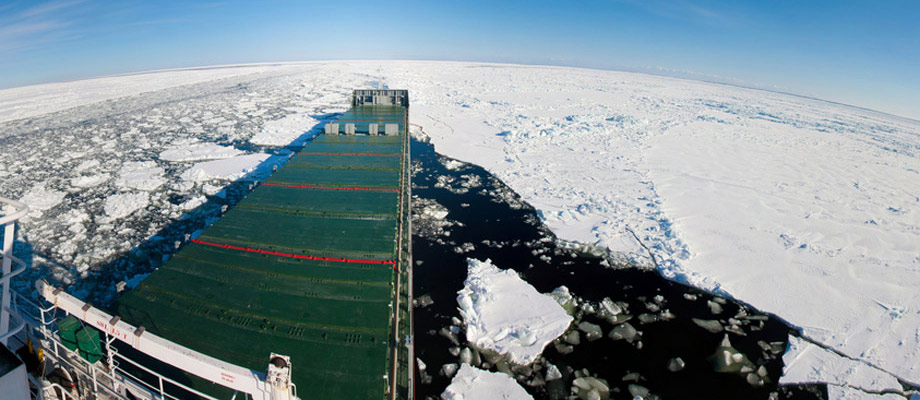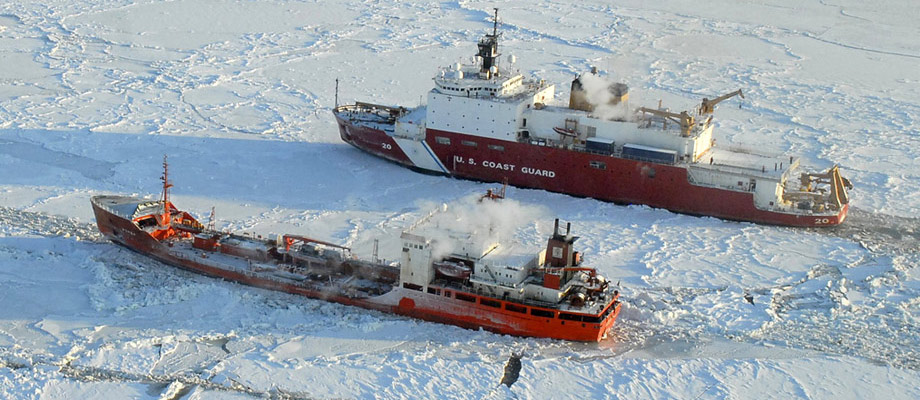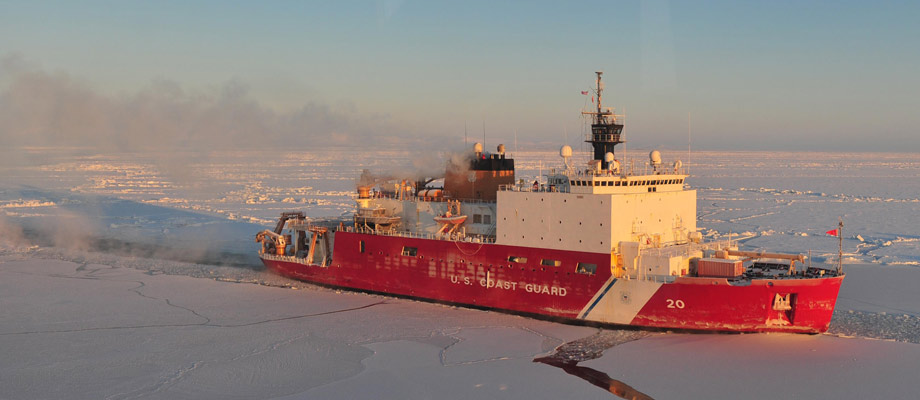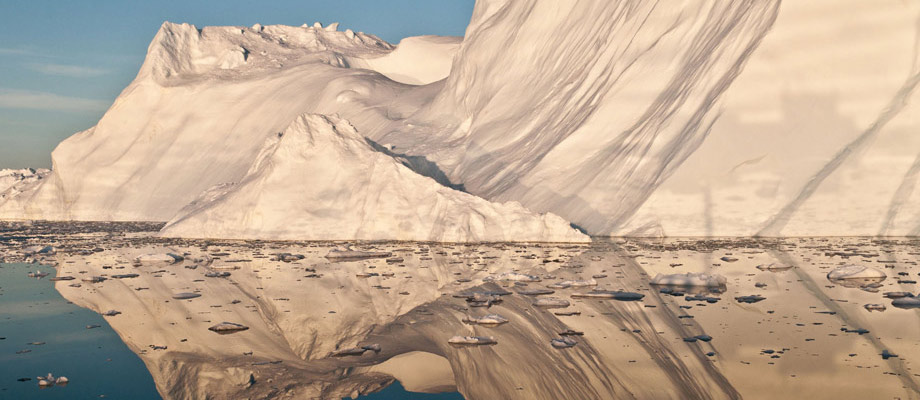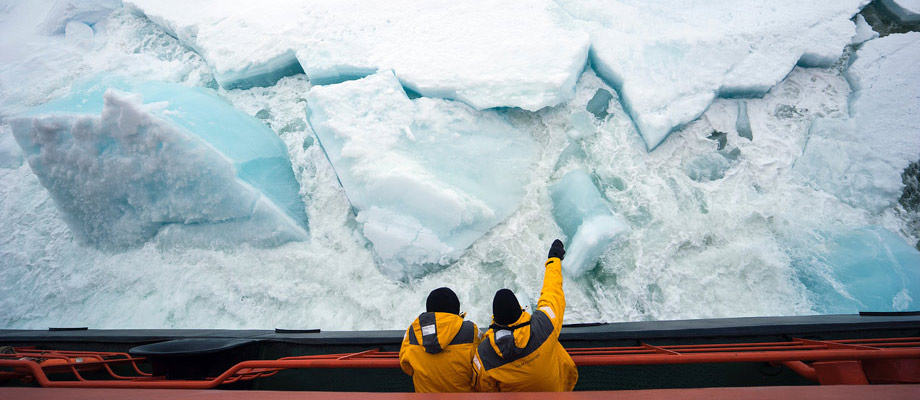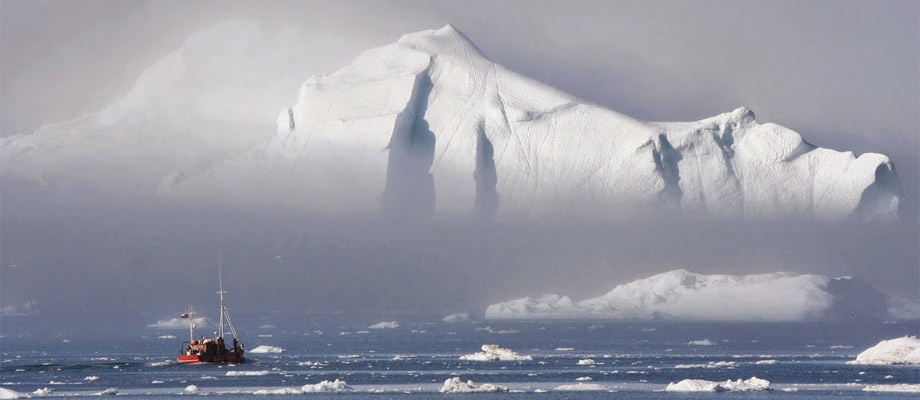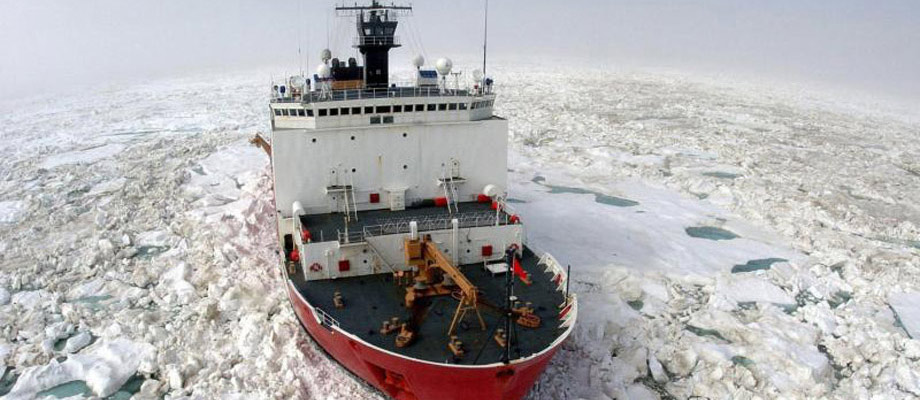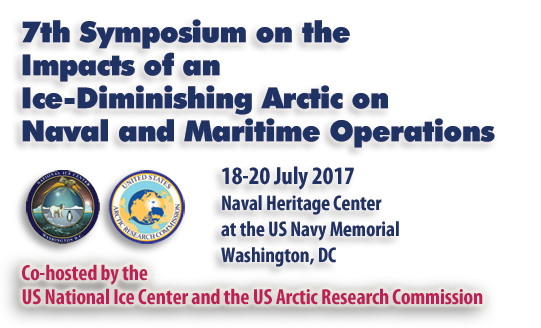Visualizations
Sea Blind: The Price of Shipping our Stuff
2015
Arctic ice melt allows commercial shipping across Russia's Northern Sea Route to be viable for the first time in history. This Arctic short-cut makes shipping even cheaper and faster than present routes by avoiding passage through the Suez canal. But the savings come at a tremendous price. Shipping is one of the most polluting and unregulated industries in the world. Colossal ships create health challenges, but worse still, the black carbon the shipping industry is allowed to emit accelerates the Arctic ice melt.
Sea Blind will be screened during the Symposium lunch breaks
Screening 1:
Tuesday, July 18
1200-1315
Screening 2:
Wednesday, July 19
1200-1315
Both screenings will be in the Naval Heritage Center Presidents Room, with an introduction by the filmmaker Bernice Notenboom.
Extremely Warm 2015-16 Winter Cyclone Weakened Arctic Sea Ice Pack - November 2015
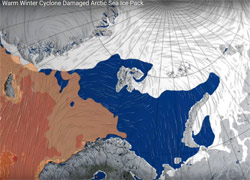 A large cyclone that crossed the Arctic in December 2015 brought
so much heat and humidity to this otherwise frigid and dry environment
that it thinned and shrunk the sea ice cover during a time of the year
when the ice should have been growing thicker and stronger, a NASA study
found. The cyclone formed on Dec. 28, 2015, in the middle of the North
Atlantic, and traveled to the United Kingdom and Iceland before entering
the Arctic on Dec. 30, lingering in the area for several days. During the
height of the storm, the mean air temperatures in the Kara and Barents
seas region, north of Russia and Norway, were 18 degrees Fahrenheit
warmer than what the average had been for this time of the year since 2003.
A large cyclone that crossed the Arctic in December 2015 brought
so much heat and humidity to this otherwise frigid and dry environment
that it thinned and shrunk the sea ice cover during a time of the year
when the ice should have been growing thicker and stronger, a NASA study
found. The cyclone formed on Dec. 28, 2015, in the middle of the North
Atlantic, and traveled to the United Kingdom and Iceland before entering
the Arctic on Dec. 30, lingering in the area for several days. During the
height of the storm, the mean air temperatures in the Kara and Barents
seas region, north of Russia and Norway, were 18 degrees Fahrenheit
warmer than what the average had been for this time of the year since 2003.
Courtesy of NASA Goddard
Weekly Animation of Arctic Sea Ice Age with Graph of Ice Age By Area: 1984 - 2016
February 2016
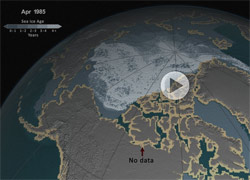 Below is an animation of the weekly sea ice age between 1984 and
2016. The animation shows the seasonal variability of the ice, growing in
the Arctic winter and melting in the summer. In addition, this also shows
the changes from year to year, depicting the age of the sea ice in
different colors. Younger sea ice, or first-year ice, is shown in a dark
shade of blue while the ice that is four years old or older is shown as
white. A color scale identifies the age of the intermediary years.
Below is an animation of the weekly sea ice age between 1984 and
2016. The animation shows the seasonal variability of the ice, growing in
the Arctic winter and melting in the summer. In addition, this also shows
the changes from year to year, depicting the age of the sea ice in
different colors. Younger sea ice, or first-year ice, is shown in a dark
shade of blue while the ice that is four years old or older is shown as
white. A color scale identifies the age of the intermediary years.
Courtesy of the NASA Visualization Studio
Extremely Warm 2015-16 Winter Cyclone Weakened Arctic Sea Ice Pack - November 2015
 A large cyclone that crossed the Arctic in December 2015 brought
so much heat and humidity to this otherwise frigid and dry environment
that it thinned and shrunk the sea ice cover during a time of the year
when the ice should have been growing thicker and stronger, a NASA study
found. The cyclone formed on Dec. 28, 2015, in the middle of the North
Atlantic, and traveled to the United Kingdom and Iceland before entering
the Arctic on Dec. 30, lingering in the area for several days. During the
height of the storm, the mean air temperatures in the Kara and Barents
seas region, north of Russia and Norway, were 18 degrees Fahrenheit
warmer than what the average had been for this time of the year since 2003.
A large cyclone that crossed the Arctic in December 2015 brought
so much heat and humidity to this otherwise frigid and dry environment
that it thinned and shrunk the sea ice cover during a time of the year
when the ice should have been growing thicker and stronger, a NASA study
found. The cyclone formed on Dec. 28, 2015, in the middle of the North
Atlantic, and traveled to the United Kingdom and Iceland before entering
the Arctic on Dec. 30, lingering in the area for several days. During the
height of the storm, the mean air temperatures in the Kara and Barents
seas region, north of Russia and Norway, were 18 degrees Fahrenheit
warmer than what the average had been for this time of the year since 2003.
Courtesy of NASA Goddard
Arctic Sea Ice Figures
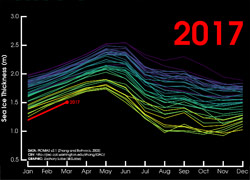 Zachary Labe is studying at UC-Irvine in Dr. Gudrun
Magnusdottir's Research Group to apply a series of GCM ensemble
experiments to understand the dynamics and relative forcings of natural
and anthropogenic climate change on this high latitude circulation and
resultant teleconnection. These animations depict ice volume, extent,
and thickness changes over recent decades.
Zachary Labe is studying at UC-Irvine in Dr. Gudrun
Magnusdottir's Research Group to apply a series of GCM ensemble
experiments to understand the dynamics and relative forcings of natural
and anthropogenic climate change on this high latitude circulation and
resultant teleconnection. These animations depict ice volume, extent,
and thickness changes over recent decades.
Courtesy of Zachary Michael Labe, University of California Irvine
The Arctic's oldest ice is vanishing - December 2016
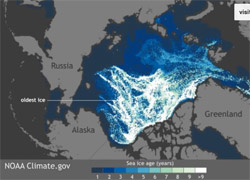 Sea ice grows throughout
the winter and melts throughout the summer, reaching its maximum extent in
late February or March, and its minimum extent in September. The ice that
survives at least one summer melt season is typically thicker and more
likely to survive future summers. Since the 1980s, the amount of this
perennial ice (or multiyear) has declined dramatically. This animation
tracks the relative amount of ice of different ages each week from 1990
through early November 2016.
Sea ice grows throughout
the winter and melts throughout the summer, reaching its maximum extent in
late February or March, and its minimum extent in September. The ice that
survives at least one summer melt season is typically thicker and more
likely to survive future summers. Since the 1980s, the amount of this
perennial ice (or multiyear) has declined dramatically. This animation
tracks the relative amount of ice of different ages each week from 1990
through early November 2016.
Courtesy of Climate.gov
- Symposium Home
- Program & Presentations
- All Videos
- Download Program PDF
- Posters
- Visualizations
Resources:
- 6th Symposium Report, (PDF, 871 KB)
- Arctic Report Card: 2016 Update
- SWIPA Report, (PDF, 4.8 MB)
Past Symposia:
- 2015 6th Symposium
- 2013 5th Symposium
- 2011 4th Symposium
- 2009 3rd Symposium
- 2007 2nd Symposium
- Naval Operations in an Ice-Free Arctic Symposium - 2001 Final Report, (PDF, 837 KB)
